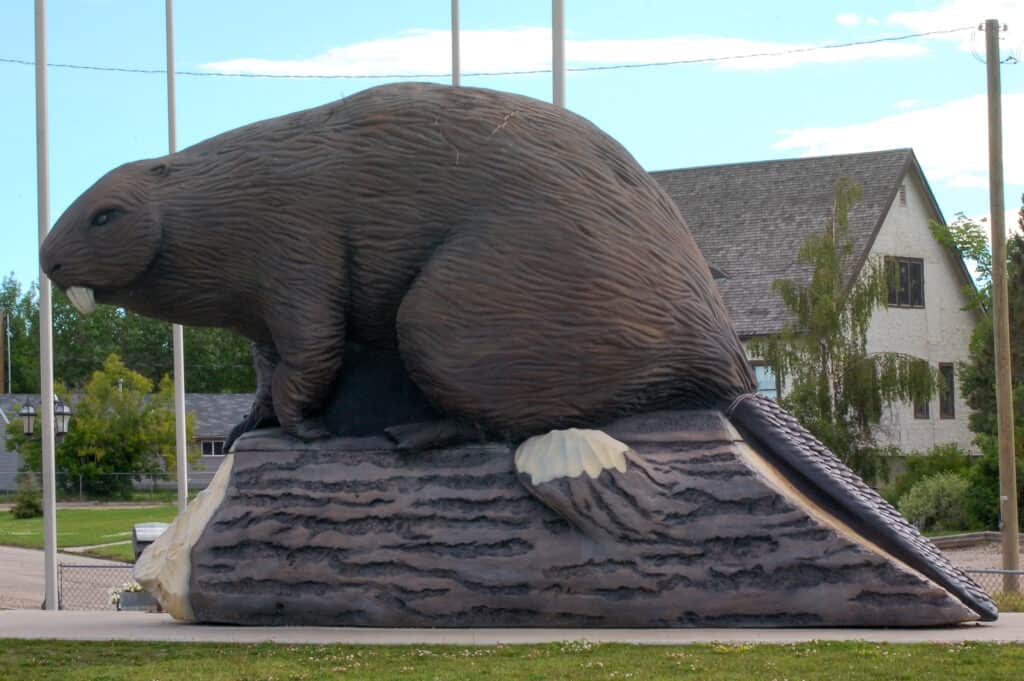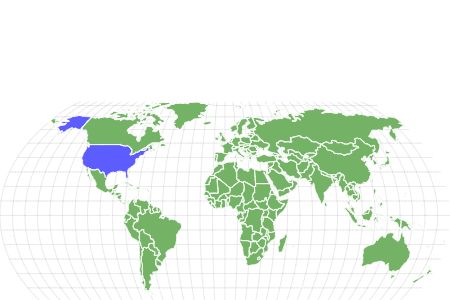The Giant Beaver are not closely related to modern beaver at all.
Advertisement
Giant Beaver Scientific Classification
- Kingdom
- Animalia
- Phylum
- Chordata
- Class
- Mammalia
- Order
- Rodentia
- Family
- Castoridae
- Genus
- Castoroides
- Scientific Name
- Castoroides
Read our Complete Guide to Classification of Animals.
Giant Beaver Conservation Status
Giant Beaver Facts
- Fun Fact
- The Giant Beaver are not closely related to modern beaver at all.
- Biggest Threat
- Loss of habitat and changing climate
- Most Distinctive Feature
- Large teeth that could get up to 6 inches long
- Habitat
- Marshes, ponds, and lakes
- Predators
- Mammoth, mastodon, ancient bison
View all of the Giant Beaver images!
Now extinct, the Giant Beaver was the size of a modern-day bear!
Even though they are not closely related to the beavers of today, these giant prehistoric rodents shared many of the same features. They probably didn’t build dams but did enjoy a mostly aquatic environment. They were most common in the American Midwest, although they ranged all the way across the North American continent.
Giant Beaver Facts
- These animals were not actually related to beavers at all.
- Their front teeth could be up to 6 inches long.
- The Giant Beaver was the largest rodent during their time, the Pleistocene period.
- They ate aquatic plants, such as cattails.
- Giant Beaver lived primarily in the Midwest, although specimens have been found from the east to west coasts of the United States.
Giant Beaver Description and Size
These beavers were truly massive. They were between 6 and 7 feet long and weighed around 200 pounds. Some researchers believe that they could get to 250 to 275 pounds. Compared to a modern beaver, which gets up to 4 feet and around 100 pounds, the Giant Beaver was quite large. They looked similar and were prehistoric rodents. However, they did have notable differences from the rodents of today.
These animals did not have the characteristic flat, paddle-shaped tails that we associate with beavers. Their tails were longer and probably narrower. They did have larger hind feet, although their hind legs were smaller in proportion to the rest of their body. The same goes for their brain. This means that they may not have had as complex of behavior, such as building, as modern beavers.
Giant Beaver had very large teeth. While many rodents have large teeth, the Giant Beaver’s teeth were giant along with the rest of its body. Their teeth were textured, which may have helped them chew tough aquatic plants that made up the majority of their diet.
They belong to the Castoroides genus and there are only two known species within this genus: C. ohioensis and C. dilophidus. Modern beavers belong to the genus Castor. Even though they share a name, modern beavers and ancient Giant Beavers are not closely related.

A replica statue of a modern beaver in Canada. The Giant Beaver and the modern beaver are not closely genetically related but do have similarities.
©LP Primeau/Shutterstock.com
Diet- What Did the Giant Beaver Eat?
Scientists do not know exactly what the Giant Beaver ate. But because some of the notable discoveries included well-preserved teeth and jaws, they do know that the Giant Beaver had a powerful bite. They might have used this to gnaw on trees and branches. However, researchers do not believe that they pulled up or cut down trees as part of their normal behavior.
Researchers do know that Giant Beaver was adapted to aquatic life. They probably ate aquatic plants, such as cattails and other grasses that grew in their environment. Giant Beavers were not solely marine mammals, however, and did come out of the water frequently during their daily lives. They were likely herbivores like many similar rodents.
Habitat- When and Where It Lived
Giant Beavers lived during the Pleistocene, roughly 2.5 million to 11,700 years ago. During this time, they lived in North America, near what is now the Great Lakes. Because they spent much of their life in the water and were not strong or fast on land, they probably didn’t disperse a lot. There is some evidence, however, of Giant Beaver as far north as Alaska and as far south and east as Florida. These specimens are few and far between. The largest concentration of fossil evidence is in the Midwest.
These animals lived in marshes and swamps where their food was plentiful and they could maneuver easily through the water. They probably favored ponds and lakes, as well as the gigantic Great Lakes. Giant Beavers did not swim out into deep water, however, preferring to stay close to shore.
Threats and Predators
Other animals of the time included mammoths, mastodons, and steppe bison. These animals may have preyed on the smaller Giant Beaver. However, Giant Beavers were not exactly easy prey due to their large size and ability to escape and maneuver in the water.
Humans probably lived alongside Giant Beaver, although not a lot of evidence suggests that they were a major source of food. Researchers did discover Giant Beaver fossils in an ancient dwelling in Ohio known as the Sheriden Cave. Many myths and legends surrounding Giant Beavers are part of ancient folklore in indigenous cultures from these areas.
Discoveries and Fossils – Where It was Found
The first Giant Beaver discovery was made in the mid-1800s in Ohio. Ohio would go on to become one of the most studied places with Giant Beaver fossils. The very first specimen was found with its teeth intact, which helped researchers of the time identify it as a rodent and help classify it within the scientific animal kingdom.
Giant Beaver fossils are most common and studied in the American Midwest. Illinois and Ohio are two states with plenty of specimens. Notable sites in Illinois include Alton, Hopwood, Clear Lake Sand and Gravel, Polecat Creek, Bellflower, New Bedford, and Phillips Park. Illinois has the highest number of sites with Giant Beaver fossils.
Other states that have evidence of Giant Beavers are Ohio, Indiana, Missouri, Michigan, Wisconsin, and Minnesota. Because Giant Beaver favored cooler climates, they did not often travel further south.
Extinction – When Did It Die Out?
One of the biggest threats to Giant Beavers was likely their limited habitat. They went extinct at the end of the Pleistocene period, around 11,700 years ago. This marked the end of the Ice Age, a time of environmental transition around the globe. Many species, including the Giant Beaver, went extinct during this time. This might be in part due to their inability to move around quickly and efficiently on land. Any change in their limited environment would have had a major impact on their survival.
Changes to their food source could have also played a role in the extinction of the Giant Beaver. They liked cooler temperatures but needed an environment with a long summer growing season. This allowed them to eat enough and store enough fat to survive through the winter. As temperatures increased, plants began to grow and bloom earlier in the year. The Giant Beaver had trouble getting the right food at the right time to be ready for the colder winter weather and lack of food.
Similar Animals to the Giant Beaver
Other prehistoric animals that lived in North America include:
View all 170 animals that start with GGiant Beaver FAQs (Frequently Asked Questions)
When was the Giant Beaver alive?
These prehistoric rodents were alive during the Pleistocene period, between 2.5 million and 11,700 years ago. This period is commonly known as the Ice Age.
How big was the Giant Beaver?
These animals could get up to 7 feet long and weight up to 275 pounds. Many specimens show that a length between 6 and 7 feet and a weight between 250 and 275 pounds was not uncommon.
Thank you for reading! Have some feedback for us? Contact the AZ Animals editorial team.
Sources
- Illinois State Museum / Accessed September 28, 2022
- Science Museum of Minnesota / Accessed September 28, 2022
- The Canadian Encyclopedia / Accessed September 28, 2022


















